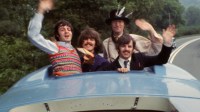Masters of the Air is the third World War II miniseries brought to life by Steven Spielberg and Tom Hanks. This installment comes more than two decades after the release of Band of Brothers and 14 years after the release of The Pacific. Masters of the Air and Band of Brothers both portray the fight against Hitler's Germany, although they approach the story of the war from different perspectives.
The new series stars Austin Butler (from “Elvis”) and Callum Turner and follows the 100th Bomb Group of the Eighth Air Force. This unit rained death and destruction on Nazi Germany from the sky despite sustaining heavy casualties that earned the unit the “Bloody Hundredth” nickname. Meanwhile, Band of Brothers followed Easy Company as they parachuted into France as part of Operation Overlord and fought to liberate Paris from the Nazis.
A different type of chaos

The chaos in Band of Brothers is really felt in the beginning episodes, as Easy Company parachutes into Nazi-occupied France at the start of the D-Day invasion. The men of Easy Company were some of the first Allied troops to set foot in Hitler's vaunted “Fortress Europe” as the push to retake Western Europe from the Nazis began.
The chaos is well documented as Easy Company first lands in France behind enemy lines. There is confusion about where troops are supposed to be, with some men landing on their targets and others landing miles away, often coming uncomfortably close to German positions.
Meanwhile, the chaos that is seen in Masters of the Air largely comes from planes getting separated, lack of reliable communication causing concerns, and enemy flak fire and fighter planes wreaking havoc among the bomber formations. The show also depicts how unfavorable weather conditions could limit visibility and add to the confusion.
We also see navigators getting air sickness and struggling to guide their planes accurately toward their target. At the beginning of the series, one navigator who is battling air sickness accidentally leads his plane over German-occupied France when they are supposed to be flying to Great Britain.
A new dynamic
We see a new dynamic in Masters of the Air that has not been explored in depth throughout the other two miniseries from Spielberg and Hanks. In the newest series, we see flyers who have successfully bailed out of their planes and landed in Nazi-occupied countries. Just in the first half of the series, we have already had a good portion of an episode dedicated to following two down flyers as they receive assistance from the French Resistance to escape the German authorities and make their way back to England.
If Masters of the Air can devote more time in the second half of the series to following these downed aviators and showing their reliance upon resistance fighters, it will be a unique angle that had not been previously explored. We will likely also get to see some of the flyers in prisoner-of-war camps, exploring the conditions that they faced as they attempted to survive the remainder of the conflict while in captivity.
When things go wrong
One major difference between Masters of the Air and Band of Brothers is the nature of things going wrong. Band of Brothers certainly has its fair share of mishaps, and we do see US troops getting killed. However, the show struggles to portray the sense that any of the main characters are truly in danger. As much as the show depicts the brutality of combat, it struggles to avoid the comforting feeling that the main characters are untouchable. We always sense that Easy Company will win the day in the end.
That is not the case at all in Masters of the Air. We have already seen both of the main characters end up getting shot down. At least we know that Bucky (Callum Turner) is alive, although he is trapped behind enemy lines. Meanwhile, Buck’s (Austin Butler) fate is uncertain as he was shot down off screen and the other bombing crews did not report seeing parachutes. As such, it is currently assumed that Buck is dead.
We saw another pilot, the confident Curtis Biddick (Barry Keoghan), pull off multiple heroic landings to save his plane and crew. When he was shot down over German-occupied territory and attempted to crash land to save his co-pilot's life instead of parachuting out, we just took it for granted that he would pull off the landing successfully. It came as a shock when his plane burst into flames upon hitting the open field.
We have seen multiple missions that were either called off or failed, in part due to losses inflicted on the 100th by the Luftwaffe and partly due to weather conditions obscuring their targets. Unfortunately for the American aviators, the unit incurred heavy losses despite not accomplishing their objectives during these failed raids.
How does Masters of the Air stack up against Band of Brothers?
Masters of the Air does things differently than Band of Brothers, and time will tell if it attains the classic status afforded to its predecessor. The new series does a great job of portraying the chaos of the conflict in a different manner than the earlier series. It does an admirable job of honestly portraying the gruesome reality of combat, showing brutal deaths and wounds.
One particularly harrowing scene shows the death of Babyface, a ball turret gunner who is trapped when the turret door jams while the plane is going down. His friend attempts to save him by prying the door open, but fails and is forced to bail out of the plane, leaving Babyface alone and consigned to face a fiery death.
One area where Masters of the Air exceeds Band of Brothers is in its ability to keep the audience feeling a true sense of danger. We never feel that the lead characters, the ones that we follow the closest and know the most about, are ever spared from the brutality of combat. At the mid-way point of the season, the two lead characters have both been shot down and one pilot who seems to always cheat death bit off more than he could chew and perished in a fiery crash.
This sense of mortality for the main characters helps to set Masters of the Air apart from Band of Brothers. We don’t have a ton of time to get to know each of the characters, but that is partly by design. Airmen died at such high rates that the flyers themselves didn’t get much time to form bonds. There was a rapid turnover cycle, with flyers getting killed and being replaced by new faces, who got killed themselves and were replaced by newer faces. The cycle would continue to repeat itself, and Masters of the Air portrays that brutal reality.



















